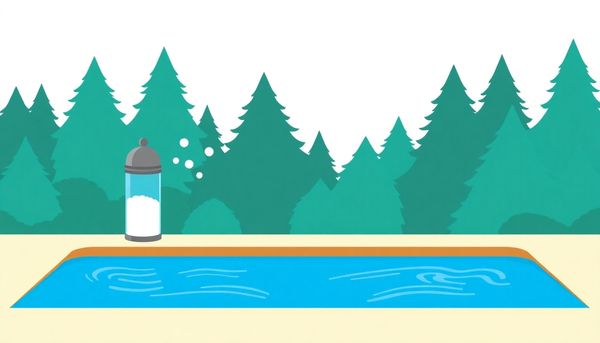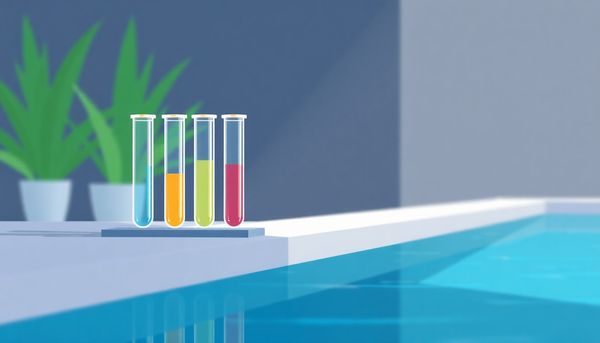Saltwater Pool Maintenance: Essential Tips for Crystal Clear Waters
November 05th, 2024
November 05th, 2024
Saltwater pools, with their gentle waves and sparkling allure, often conjure images of effortless relaxation. However, maintaining them is more akin to nurturing a delicate ecosystem than merely lounging beside crystalline waters. My neighbor, for instance, invested in a saltwater pool last summer, dreaming of seamless maintenance and skin-friendly swims. Yet, it wasn't long before she found herself tangled in a web of unforeseen complexities. In our conversations, she revealed that the pool, while initially enchanting, required an understanding far beyond her expectations.
Many pool owners, enchanted by the promise of reduced chemical use and lower maintenance, might overlook the specifics that keep these watery retreats in prime condition. In her quest for ease, my neighbor discovered that misconceptions and overlooked tasks led to unexpected challenges. For instance, she learned that failing to regularly check the salt chlorine generator can result in improper chlorination, leading to cloudy waters and uninvited algae blooms.
Each saltwater pool holds unique demands, from balancing salinity levels to maintaining the correct pH. Neglecting these responsibilities can lead to a cascade of issues, reminiscent of the time my neighbor found herself battling corrosion on her pool fixtures due to a neglected stabilizer level. As we explore these common pitfalls, understanding the nuances of saltwater pool care becomes essential, ensuring that your pool remains a sanctuary, rather than a source of frustration. Let's unravel these maintenance mysteries together, drawing on both personal experiences and expert advice.

Salt, the unassuming hero of a saltwater pool, can quickly become a villain if overused. Unlike the instant feedback you get with traditional chlorine pools, the effects of excess salt can sneak up on you, often resulting in costly repairs and headaches. My neighbor learned this the hard way when he generously topped up his pool with salt after a hefty rainstorm, thinking more was better. What followed was a cascade of problems: a malfunctioning salt generator and crystal-like salt deposits forming unsightly rings on his pool tiles.
When managing a saltwater pool, precision is your best friend. Salt doesn’t evaporate like water; it accumulates. Therefore, it's crucial to add salt incrementally. Begin by verifying the recommended salinity levels in your salt generator’s manual, typically ranging from 2700 to 3400 ppm. Always double-check with a digital salinity reader or salt test strips. This helps in catching discrepancies your pool system might miss.
Incorporate a routine check, ideally monthly, or more frequently after heavy rainfall or excessive pool usage when salt levels are likely to fluctuate. If you find the salt level too high, diluting your pool water is the most effective remedy. Remember, a little caution upfront saves not just your pool, but also your time and money in the long run. Your pool will thank you with clearer, trouble-free waters all season long.
Balancing chlorine levels in your saltwater pool is a bit like maintaining a delicate equilibrium in a small ecosystem. Although the saltwater generator diligently creates chlorine, ensuring that it's in the right range is crucial for a sparkling, safe swim. The sweet spot for free chlorine levels lies between 1 and 3 parts per million, with 3 ppm being the gold standard. This balance not only keeps the water inviting but also protects your skin and eyes from irritation.
Weekly testing becomes your best ally. Whether you prefer test strips or a liquid test kit, regular checks allow you to tweak the generator's settings to maintain that ideal chlorine concentration. It’s like tuning a musical instrument; small adjustments can lead to harmonious results. And remember, you can afford a slightly higher chlorine level compared to traditional pools due to the nature of saltwater generation—gentler yet effective.
Speaking of salt levels, these play a significant role too. The generator needs enough salt to function properly, so make sure the salinity is within the recommended range. Inaccurate readings can sometimes occur, so manually checking with a digital salinity reader, especially after heavy rain or pool parties, can prevent imbalances. This diligence ensures your pool not only stays clear but also prolongs the life of your equipment, avoiding that dreaded calcium build-up on the salt cell. Balancing these elements creates a pool environment that's as refreshing as it is low maintenance—a true win-win situation.
In the realm of salt water pool maintenance, achieving the right pH balance is akin to striking the perfect chord in a symphony. Despite the allure of reduced chemical use in salt water systems, pH levels often require more vigilance. Salt water generators, while they effortlessly produce chlorine, tend to nudge the pH upwards, sometimes beyond the ideal range of 7.2 to 7.6. This high pH can not only irritate swimmers' skin and eyes but also pave the way for pesky scaling on pool surfaces and equipment.
A friend of mine once ignored his pool’s pH balance, dismissing the cloudy water and occasional stinging eyes as mere inconveniences. It wasn't until his pool pump began faltering, and costly repairs loomed, that he realized the oversight. Regular testing can prevent such mishaps. Equip yourself with a reliable liquid test kit or digital meter, and make pH checks as routine as your morning coffee.
If your readings tilt towards the high side, don't fret. Muriatic acid or a pH decreaser can bring harmony back to your pool. For those battling perpetually high levels, examining other variables like the alkalinity or even the generator's run time can shed light on the root cause. Remember, maintaining the right pH not only enhances swim comfort but also prolongs the life of your pool equipment, ensuring your oasis remains a place of joy rather than a source of frustration.
Navigating the waters of salt water pool maintenance requires a keen eye on salinity levels. Unlike traditional pools, where chemicals are the stars of the show, salt water pools demand a more nuanced approach. The balance of salt is crucial; too little, and your chlorine generator won't hit its stride, leaving your pool vulnerable to algae and bacteria. On the flip side, an excess can lead to equipment corrosion or a salty-tasting swim.
Regular testing, at least once a month, is essential. During the pool season, invest in a reliable digital salinity reader to ensure precision beyond what a salt water generator display might offer. These devices provide an accurate reading that can guide your adjustments, especially following heavy rain or an influx of splash-out, both of which can skew salinity levels. A personal anecdote reminds me of a summer downpour that caught me off guard. My trusty digital reader was the hero, pinpointing the drop in salinity before issues arose.
Adjusting salinity is a gradual process. When adding salt, patience is your friend. Introduce it slowly, allowing your generator to process and stabilize levels. Overzealous additions can be a hassle to reverse. Similarly, if faced with high levels, dilution through partial draining is your best bet. Remember, understanding the specific requirements of your pool's generator can save you from guesswork and potential mishaps. With the right balance, your salt water oasis can provide a refreshing, gentle swim all season long.

Balancing chlorine levels in a salt water pool is like walking a tightrope, requiring precision and regular attention. For many, the allure of a salt water pool lies in its promise of gentler water, but this doesn’t negate the need for diligent chlorine management. A common misunderstanding is that, with salt water pools, chlorine becomes less of a concern. However, the reality is quite the opposite. The salt water generator transforms salt into chlorine, ensuring your pool stays sanitized, but this process necessitates regular monitoring to maintain the ideal chlorine balance between 1 and 3 parts per million (ppm).
Weekly testing of your pool water is essential. Whether you prefer test strips or a liquid test kit, these tools reveal the chlorine content and guide any necessary adjustments to your generator. It's worth noting that maintaining a slightly higher chlorine level than in traditional pools can be beneficial due to the unique dispersion method of the salt water generator.
Neglecting this aspect can lead to issues such as algae growth or inadequate sanitation. I once skipped a few weeks of testing, only to find an unexpected green tinge to my pool—a vivid reminder of the importance of regular checks. Embracing a routine, where checking chlorine levels becomes as natural as watering your plants, ensures a sparkling and safe swimming environment free from surprises.
Keeping a saltwater pool in top shape involves a delicate dance with your chlorine levels, produced by the unassuming yet mighty salt water generator. This ingenious device works tirelessly, transforming salt into chlorine, ensuring your pool remains inviting and sanitized. However, it's crucial to monitor this conversion process to maintain that perfect balance.
Start by testing your water every week. Just as you wouldn't skip checking the oil in your car, neglecting chlorine levels can lead to murky waters or even skin irritations. Use test strips or a liquid test kit to measure the free chlorine, aiming for that sweet spot between 1 and 3 parts per million. If levels dip or soar, a simple adjustment of your generator can set things right. Consider it a quick tune-up for your aquatic haven.
Chlorine may be kinder on the senses in a saltwater pool, but don’t let that lull you into complacency. High temperatures and heavy pool use can demand more chlorine. If you find your pool in need of a pick-me-up, the generator's "BOOST" mode can be a lifesaver, offering a quick spike in chlorine levels.
While it might seem like added work, keeping an eye on chlorine production ensures your pool remains a tranquil retreat. It's a bit like tending to a garden; with regular attention, your efforts will blossom into a pristine, refreshing oasis. This diligence not only maintains your pool’s health but also enhances every swim, transforming each dip into a pleasure.
In the realm of salt water pool care, maintaining the pH balance is akin to finding harmony in a symphony. Too high, and your pool's water becomes a source of discomfort, leading to irritated skin and eyes. Too low, and the effectiveness of your chlorine drops, opening the door to unwanted guests like algae. A delicate equilibrium, your pH level should ideally hover between 7.2 and 7.6.
For those experiencing persistently high pH levels, a salt water generator is usually to blame. This ingenious device, while gracefully converting salt to chlorine, has a tendency to nudge the pH upwards. Regular testing is your best ally here. A simple liquid test kit or test strips can reveal the truth in mere moments.
Once a high pH is detected, it's time for a careful intervention. Muriatic acid or a pH decreaser can be your go-to solutions. However, it’s not just about pouring chemicals into the pool and hoping for the best. Measure precisely and add gradually, always keeping an eye on the readings after each adjustment.
A personal reminder from someone who’s been there—don’t neglect the alkalinity. While not the star of the show, it plays a supporting role, buffering pH fluctuations. If your alkalinity is out of sync, it’s akin to a wobbly foundation in the house of your swimming sanctuary. Balance them hand in hand, and your salt water pool will reward you with shimmering, inviting waters.
The ocean calls, even in your backyard, with the alluring promise of a salt water pool. Yet, this serene oasis requires a vigilant eye on salinity levels. Unlike traditional chlorine pools, salt water pools rely on a delicate balance to keep things perfect. Overlooking salinity testing is a common misstep, but one easily avoided with consistent monitoring.
Monthly salinity checks are essential, but consider increasing frequency after heavy rainfall or substantial water loss. These changes can unexpectedly alter your pool’s salt levels. A digital salinity reader can provide precise readings, ensuring your salt water generator functions optimally. This tool can be as indispensable as your favorite pool float, offering peace of mind with every effortless dip.
Personal experience reveals the importance of this routine. Once, after an unanticipated thunderstorm, I noticed my pool’s generator struggling. A quick salinity test exposed the culprit: diluted salt levels. A timely adjustment prevented what could have been an extended period of murky waters.
Your salt water generator may display current salinity levels, but always trust, and verify, with manual testing. Systems can falter, reporting misleading figures, especially if salt levels venture into extreme ranges. By maintaining an appropriate salinity balance, you not only ensure crystal-clear waters, but also extend the life of your pool equipment. So, grab that digital reader and make monthly testing a priority—your backyard ocean will thank you.

Every salt water pool enthusiast knows the importance of keeping the water chemistry in balance, yet one common oversight is neglecting to regularly test pH and alkalinity. These two elements are the unsung heroes in maintaining a comfortable swimming environment and protecting your pool equipment. I once noticed my pool's water looking a bit cloudy, and after some puzzled troubleshooting, realized I hadn’t checked the pH and alkalinity in weeks. A quick test revealed that my pH was soaring above 8.0, leading to scaling on my tiles and mild irritation on swimmers’ skin.
Regular testing with reliable test kits or digital meters can save you from such hassles. While pH levels should ideally hover between 7.2 and 7.6, alkalinity acts as a buffer, stabilizing these pH levels. In a salt water pool, alkalinity should be between 80 to 120 ppm. If it dips too low, your pH can swing wildly, while consistently high levels may lead to unsightly calcium deposits.
Adjusting alkalinity might involve adding baking soda, while stubbornly high pH levels might require a dose of muriatic acid or a pH decreaser. Remember, the salt water generator naturally increases pH over time, so monitoring is crucial. Regular checks not only prevent equipment damage but also ensure that swimmers enjoy crystal clear, irritation-free water. Keeping these levels in check means you can truly savor the tranquility of your backyard oasis.
Salt water pools offer a luxurious swimming experience, but maintaining the right pH balance is crucial to keep it that way. A friend of mine learned this the hard way. One summer, he noticed his pool water turning cloudy and his kids complaining of itchy skin after a dip. After some detective work, he found that neglecting weekly pH checks was the culprit. In salt water pools, the generator's natural tendency is to increase the pH, often pushing it beyond the ideal range of 7.2 to 7.6. This not only affects swimmer comfort, causing skin irritation and eye discomfort, but also leads to unsightly scaling on pool equipment.
To avoid these issues, it's essential to check and adjust pH levels weekly. You can use a reliable test kit or digital pH meter for accuracy. If the reading is above 7.6, consider using a pH decreaser or adding muriatic acid to bring it back to balance. Just a small adjustment can prevent the build-up of calcium deposits, saving you from more costly maintenance down the road.
Moreover, if you find your pH constantly on the high side, evaluate other factors like your generator's run time. Overuse can exacerbate pH imbalance, so limiting operation to no more than 10 hours a day might be necessary. By keeping a close eye on your pH levels, you're not just preserving your pool equipment; you're ensuring a more enjoyable and safe swimming experience for everyone.
Managing alkalinity in a salt water pool demands a touch of precision. One might think that with a reduced chemical regimen, there's less to worry about. Yet, alkalinity plays a crucial role in maintaining the overall health of your pool, acting as a buffer to prevent sudden pH swings, which could lead to murky water or irritated skin.
When the alkalinity drifts too low, your pool water can become corrosive, damaging surfaces and equipment. On the other hand, if it climbs too high, it can cause scaling and cloudy water issues. Aiming for a sweet spot between 80 and 120 parts per million (ppm) provides stability. I remember a time when I overlooked my pool's alkalinity while focused on other parameters. The oversight led to an annoying battle with cloudy water that took weeks to settle.
Adjustments should be gradual. If you find the alkalinity lacking, baking soda serves as a reliable increaser. For those moments when alkalinity needs toning down, a pH decreaser or muriatic acid can do the job. However, take care not to alter the levels too quickly, as this could upset the delicate balance you’re striving to maintain.
Regular testing, ideally once a week, keeps you informed and empowers you to make timely corrections. Think of this process as fine-tuning a musical instrument—consistent attention ensures harmony within your salt water oasis.
A serene swim in a salt water pool can easily turn into a maintenance nightmare if salinity levels are neglected. Unlike traditional chlorine pools, salt water systems rely on precise salinity to effectively generate chlorine. Keeping an eye on this aspect isn't just a suggestion; it's a necessity for smooth operation and the longevity of your pool equipment.
During a warm summer month, you might notice your pool isn't quite as refreshing. A quick dip in water testing can reveal all. Salinity levels can be affected by factors beyond your control, like heavy rainfall or splash-outs from enthusiastic swimmers, diluting the salt content you meticulously balanced. Pull out that digital salinity reader and get a precise measure. If it's the beginning of the pool season, or after a rainstorm, testing becomes even more crucial. Regular assessments each month ensure that the generator functions optimally, avoiding issues like low chlorine production or the dreaded corrosion on metal components.
From personal experience, investing in a reliable testing method pays dividends. Last summer, a heavy downpour knocked my salinity off balance, leading to a cloudy pool and frustrated swimmers. After diligently checking and adjusting the salt levels, my pool was back to its inviting self. It’s a small, regular commitment that saves time, money, and effort in the long run. So, don’t let salinity slip through the cracks; it’s the key to a trouble-free swimming season.

Calcium build-up can sneak up on even the most diligent salt water pool owner, turning your maintenance ritual into a battle against stubborn scale. It's a common issue that can quietly damage your pool's salt cell and equipment if not addressed properly. Your pool water's calcium hardness level is the main culprit behind this persistent problem. If the levels rise too high, calcium deposits start forming, not just on your salt cell, but also on pool surfaces and equipment, leading to potential damage and efficiency loss.
Remember the time you noticed that stubborn white line around your kitchen kettle? It’s a similar story here. To prevent such unsightly scaling, diligently monitor and balance your water’s calcium hardness levels, keeping them ideally between 200 and 400 parts per million (ppm). Regularly testing your pool water is crucial. If you discover calcium levels creeping up, consider partially draining and refilling with fresh water to dilute the minerals. Alternatively, using a hose filter when topping up can help prevent adding more calcium into the mix.
In addition, cleaning your salt cell every three months can work wonders. A gentle rinse with a high-pressure hose often does the trick, but for more stubborn deposits, a diluted muriatic acid solution can help. Just be cautious and follow the manufacturer's instructions carefully. Staying ahead of calcium build-up not only ensures your pool equipment's longevity but also keeps your swimming experience enjoyable and hassle-free.
Balancing pH levels in a salt water pool is crucial for maintaining a pleasant swimming experience and safeguarding your pool equipment. Unlike traditional pools, salt water pools naturally tend to have higher pH levels due to the operation of the salt water generator. This can lead to uncomfortable swimming conditions and equipment scaling if left unchecked. My friend once shared a story about how his pool became a chemistry experiment gone wrong, simply because he overlooked his pH levels for a few weeks. His water turned cloudy, and guests at his pool party were left with itchy eyes and skin.
Regular testing is your first line of defense. A weekly ritual of testing pH levels ensures that they remain in the ideal range of 7.2 to 7.6. If you find your pH levels creeping upwards, a pH decreaser or a dose of muriatic acid can bring them back into balance. Once, I found myself in a similar predicament during a particularly hot summer—avoiding the issue was not an option. A quick adjustment with the right chemicals made all the difference, restoring the water to its inviting clarity.
Remember, balancing pH isn't just about comfort; it's about the longevity of your pool system. Prevent calcium scaling on your equipment by keeping these levels in check and your pool experience will remain enjoyable and hassle-free. Take it from someone who's learned the hard way—consistent monitoring is key to a happy, healthy pool.
The serenity of a salt water pool is a joy, yet maintaining it requires a keen eye, particularly when it comes to the salt cell. Over time, calcium scaling can quietly accumulate on the cell, undermining its efficiency and potentially leading to costly repairs. A friend of mine learned this the hard way when her pool's chlorine output dropped unexpectedly, a direct result of neglected scaling.
Every three months, and certainly at the start and close of the swimming season, it's wise to give your salt cell a thorough inspection. Begin by turning off your pool system and removing the cell for a close look. If you spot any white, chalky deposits, that's calcium scaling—a common adversary in salt water pools. A simple rinse with a high-pressure hose can dislodge minor build-up, but more stubborn deposits may require a diluted muriatic acid solution. Always remember to handle acids with care, using protective gear as needed.
Besides physical cleaning, consider the factors contributing to the scaling. High calcium hardness in your pool water often exacerbates the problem. Keeping these levels in check can prevent scaling from becoming a recurring nuisance. By routinely inspecting and maintaining your salt cell, not only do you prolong its lifespan, but you also ensure that your pool remains a haven of clear, comfortable water.
Navigating the waters of salt water pool maintenance involves a dance of precision, particularly when it comes to salinity levels. Unlike traditional pools where chemical juggling is routine, salt water pools demand a different kind of attention. The salt dissolved in your pool water isn't just a seasoning; it’s the lifeblood of your salt generator, transforming into the chlorine that keeps your pool sparkling clean.
One might assume that the more salt, the better, but that's a slippery slope. Too much salt can lead to corrosion of pool fixtures and damage to your salt cell, while too little renders the generator ineffective. I recall a friend who poured in salt with reckless abandon, only to find her pool liner looking like it had aged a decade overnight. Regularly testing your water with a digital salinity reader or salt strips can spare you this poolside drama. It's a bit like checking the oil in your car; it might feel tedious, but it’s essential for smooth operation.
Don't overlook the natural factors at play. Heavy rain or pool parties can dilute your salt levels significantly. It's wise to check after such events, as well as monthly during pool season, to keep your pool's salinity in the sweet spot. Remember, maintaining ideal salinity is key to a harmonious swimming experience, much like balancing spices in a well-loved recipe.

Maintaining a salt water pool demands a little extra attention, especially when it comes to the salt cell. Over time, calcium deposits can build up on the cell, which hampers its efficiency and can lead to a costly replacement. Checking the salt cell every three months, as well as at the start and end of the swimming season, can keep it in peak condition.
During inspection, it's crucial to look for any signs of scaling or mineral deposits. A high-pressure hose often works wonders for flushing away minor build-ups. However, for more stubborn deposits, a gentle soak in a diluted muriatic acid solution can do the trick. Always handle the acid with care, and follow the instructions provided by your salt water generator's manufacturer.
From my own experience, I’ve learned that a little preventative maintenance goes a long way. Once, after neglecting my salt cell for an entire season, I found a thick layer of crusty deposits that took hours to clean. Since then, I make it a point to check my salt cell routinely. This simple task not only saves me time and money but also ensures my pool water stays crystal clear, offering a more enjoyable swimming experience for my family and friends. Regular cleaning maintains efficiency and extends the life of your equipment, making it a worthwhile investment of your time.
In the realm of salt water pool maintenance, one often overlooked aspect is the insidious build-up of scale within your salt cell. This problem sneaks up gradually, masking itself until it begins to hinder your pool system's efficiency. Scale build-up occurs when calcium deposits accumulate, obstructing the salt cell's ability to produce chlorine effectively. I've seen it firsthand when my friend’s pool suddenly turned from a sparkling oasis to a murky swamp. The culprit? A neglected salt cell choked with scale.
It's critical to incorporate regular inspections into your maintenance routine. Every three months, or at the start and end of the swim season, detach the salt cell and scrutinize it for any crusty white deposits. If you spot any scale, a forceful rinse with a high-pressure hose can help dislodge the milder build-up. However, for more stubborn deposits, a diluted muriatic acid solution works wonders. Always make sure to follow your generator’s specific cleaning instructions to avoid damaging the equipment.
Ignoring scale build-up doesn’t just reduce chlorine production; it can lead to increased electricity use and shorten the lifespan of your generator. Regular checks and cleaning not only keep your pool water crystal clear but also extend the life of your equipment. Taking these steps will ensure that your pool remains a joy rather than a chore.
A sunny afternoon spent lounging by the saltwater pool can swiftly turn sour if your maintenance routine overlooks essential practices. One frequently underestimated task involves the strategic use of a high-pressure hose. Saltwater pools might not demand the constant addition of chemicals like their chlorinated counterparts, but they do require vigilance against salt build-up, especially on pool equipment.
Picture your salt cell as the heart of your pool's chlorination system. Over time, calcium and other minerals can accumulate, potentially strangling its efficiency. A high-pressure hose becomes your best ally here. Regularly flushing the salt cell with a powerful jet of water can dislodge stubborn deposits, ensuring optimal performance. It's like giving your pool system a refreshing shower, stripping away grime and extending the life of your equipment.
Once every three months, or more if you've noticed a decline in chlorine levels, take a moment to inspect the cell. You might be tempted to skip this step, thinking your pool looks just fine. However, neglecting this simple procedure could lead to costly repairs or the headache of premature equipment failure. Moreover, while tackling tough deposits with muriatic acid is sometimes necessary, starting with a high-pressure hose can minimize the need for harsh chemicals.
Let the high-pressure hose be your first line of defense. In doing so, you maintain the delicate balance of your saltwater haven, keeping it ready for those carefree swims and lazy afternoons.

This article provided insights into maintaining your pool. Start your pool care journey today!
Want to become a pool maintenance expert? Our free Pool School course covers everything you need to know about pool care. From basic maintenance to advanced troubleshooting, you'll learn how to:
Join over 10,000 pool owners who have already transformed their pool care routine. Get started with our free Pool School course today!